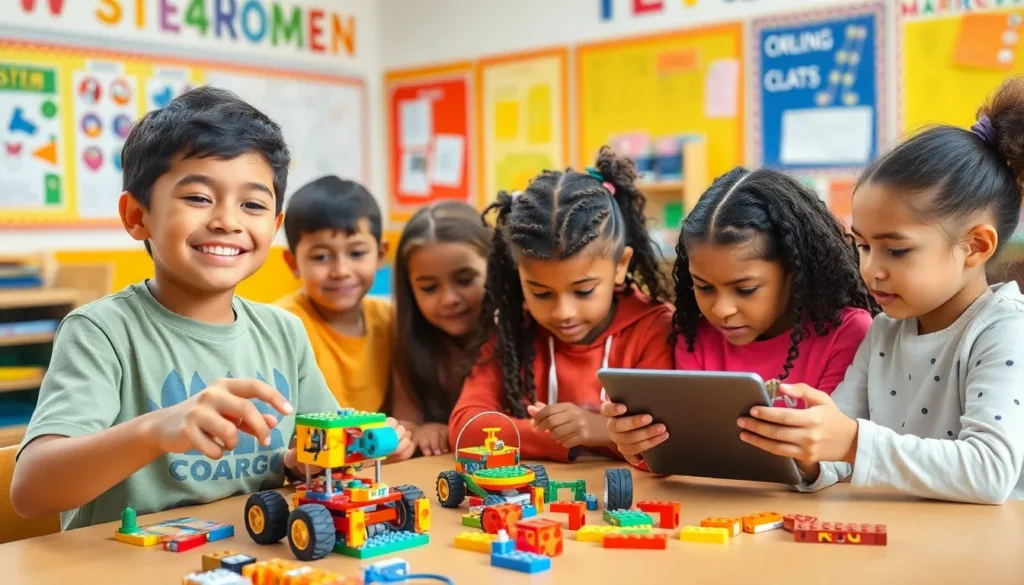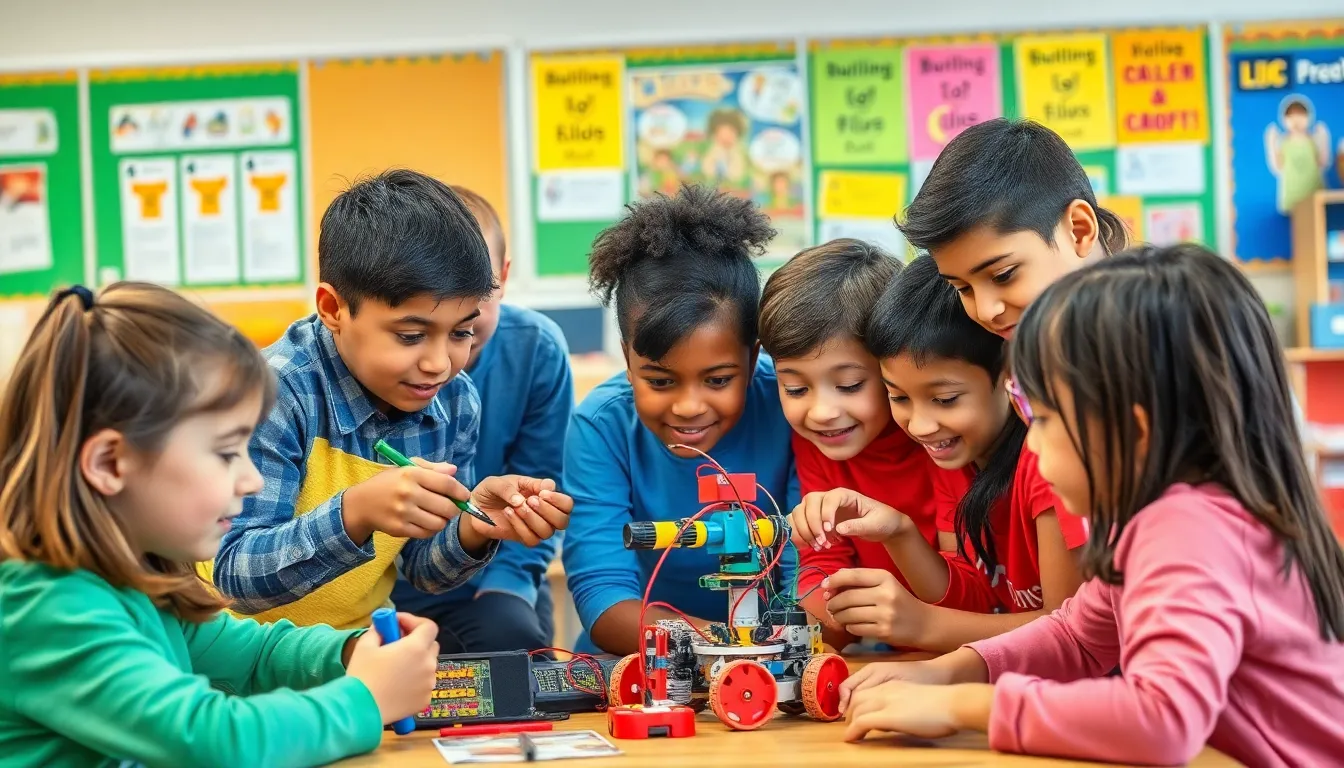Imagine a world where kids build their own robots and program them to do everything from dance to fetch snacks. Sounds like a scene from a sci-fi movie, right? Well, welcome to the exciting realm of robotics for elementary students! This isn’t just about playing with cool gadgets; it’s about sparking creativity and nurturing problem-solving skills in young minds.
Robotics education opens doors to a fun-filled learning experience that combines science, technology, engineering, and math—often referred to as STEM. As children dive into this hands-on adventure, they develop critical thinking skills while having a blast. Who knew that building a robot could lead to mastering coding and teamwork? Get ready to explore how robotics can transform the classroom into a playground of innovation and imagination.
Table of Contents
ToggleOverview of Robotics for Elementary
Robotics education for elementary students opens doors to creativity and innovation. This field combines play with learning, allowing children to explore science, technology, engineering, and mathematics (STEM) in an engaging manner. Engaging with robotics, students cultivate critical skills that extend beyond the classroom.
Children learn to build and program robots, providing hands-on experience in coding. Through this process, students improve their problem-solving abilities. They collaborate in teams, enhancing their social skills while working on projects. Robotics fosters an environment where students feel safe to experiment and make mistakes.
These educational experiences are often enriched by various tools and resources. Many schools use programmable kits, like LEGO Mindstorms or VEX Robotics, to support learning. These kits encourage creativity while providing structured guidance for novice builders. Robotics competitions may also stimulate interest and motivate students to refine their skills.
Incorporating robotics into the curriculum leads to increased engagement. Students often express enthusiasm when learning through projects that incorporate real-world applications. As they interact with technology, their confidence builds, paving the way for future learning opportunities.
Elementary robotics education serves as a foundation for future pursuits. Establishing early familiarity with technology prepares students for advanced topics later on. Through tailored programs, educators can effectively introduce complex concepts in a manageable way. Ultimately, robotics serves as a catalyst for developing the next generation of innovators.
Importance of Robotics in Education
Robotics plays a crucial role in education, particularly for elementary students. Engaging with robotics provides a platform for learning essential skills and concepts.
Enhancing Problem-Solving Skills
Students develop critical problem-solving skills through hands-on experiences. Building and programming robots requires them to troubleshoot and adapt their strategies. These tasks encourage creativity and independent thinking. Engaging with programmable kits like LEGO Mindstorms exposes students to real-world challenges. When faced with obstacles, they learn to iterate on their designs, fostering resilience. Each project presents an opportunity to explore various solutions, enhancing their analytical abilities and preparing them for complex scenarios.
Encouraging Teamwork and Collaboration
Collaboration thrives in robotics education, as most projects involve teamwork. Students work together to design, build, and program their robots, fostering effective communication. Group activities develop interpersonal skills and create a sense of community. Discussing different ideas and perspectives during the design process enhances their collective creativity. Peers learn to respect individual contributions, reinforcing collaboration skills. As they tackle challenges collectively, they also strengthen their social interactions. Participating in competitions further cultivates teamwork, motivating students to support each other in achieving common goals.
Key Components of Robotics Curriculum
An effective robotics curriculum includes essential components that engage elementary students in exciting ways. Each element contributes to a holistic educational experience.
Programming Basics
Programming forms the backbone of robotics education. Students learn fundamental coding concepts, often using block-based platforms like Scratch or more advanced languages such as Python. Engaging with programming helps children develop logical thinking and problem-solving skills. Exercises can involve simple tasks, such as moving a robot forward or completing an obstacle course. Mastery of these basics lays a strong foundation for future projects and technology-related endeavors.
Hands-On Activities
Hands-on activities are pivotal in making robotics accessible and enjoyable. Students participate in building, assembling, and troubleshooting robots using kits like LEGO Mindstorms or VEX Robotics. These experiences promote active learning, allowing kids to apply theoretical concepts in practical situations. Projects may range from individual creations to collaborative builds, where teamwork enhances the learning process. Such activities stimulate interest, ignite creativity, and reinforce technical skills necessary for success in STEM fields.
Integration with STEM Subjects
A robust robotics curriculum tightly integrates STEM subjects. Incorporating science, technology, engineering, and math leads to a dynamic learning environment. For instance, students might explore physics concepts while programming robots to navigate different terrains. Integrating math concepts allows for exploring measurements and algorithms within robotics tasks. Combining these subjects encourages students to view connections among disciplines, fostering a broader understanding of technology and its real-world applications.
Popular Robotics Kits for Elementary Students
Educational robotics kits engage elementary students with hands-on learning experiences. These kits blend creativity and technology, fostering a love for STEM subjects.
LEGO Education SPIKE
LEGO Education SPIKE combines construction and coding, making it a favorite among young learners. This kit includes colorful building elements and easy-to-use software for programming. Students create and program robots while exploring engineering concepts like problem-solving and design. SPIKE promotes collaborative teamwork, allowing children to navigate challenges together. Its intuitive interface encourages students to experiment and iterate on their designs, enhancing critical thinking skills. Moreover, lesson plans support educators in integrating robotics seamlessly into the classroom.
VEX Robotics
VEX Robotics provides versatile kits that cater to various skill levels in elementary education. Users can build complex robots using customizable components, encouraging creativity in design. Programming options like VEXcode offer a visual coding experience, making it accessible for beginners. Students engage in competitions, fostering a spirit of innovation and teamwork. The hands-on nature of VEX Robotics empowers children to tackle real-world engineering problems while reinforcing their analytical and technical abilities. Resources are available for educators to help coordinate lessons that inspire exploration and learning.
Challenges in Implementing Robotics
Implementing robotics in elementary education presents several challenges.
Funding and Resources
Securing funding poses a significant challenge for many schools. Budget constraints limit access to necessary resources. Schools often struggle to acquire robotics kits and educational materials like LEGO Education SPIKE and VEX Robotics. These kits enhance hands-on learning experiences and foster creativity. Additional financial support from grants or local partnerships can help bridge these gaps. Investing in professional development for educators also remains essential. Schools that prioritize funding for robotics programs are more likely to succeed in integrating robotics into their curriculum.
Teacher Training and Support
Training educators in robotics is crucial for program success. Many teachers lack the confidence and skills needed to effectively teach robotics concepts. Professional development programs focused on robotics help build this expertise. Supportive networks among educators can create collaborative learning environments. Schools must provide continuous training opportunities to ensure teachers stay current with evolving technologies. Investing in teacher support contributes to a more comprehensive robotics education experience, fostering better outcomes for students.
Conclusion
Robotics education in elementary schools is transforming how young learners engage with STEM subjects. By fostering creativity and collaboration, it equips students with essential skills that extend beyond the classroom. As children build and program robots, they not only enhance their problem-solving abilities but also cultivate teamwork and communication skills.
The integration of hands-on learning experiences through popular robotics kits makes this educational approach both enjoyable and impactful. While challenges like funding and teacher training exist, the benefits of robotics in developing future innovators are undeniable. Embracing robotics education lays the groundwork for a generation ready to tackle real-world challenges with confidence and creativity.







